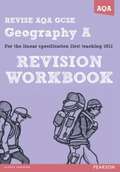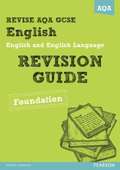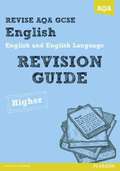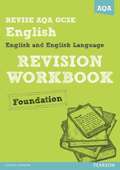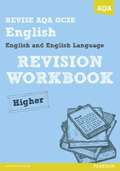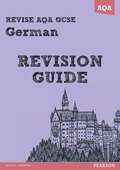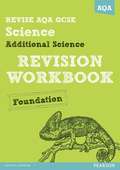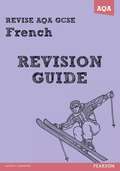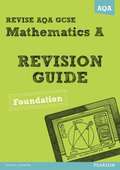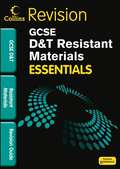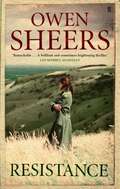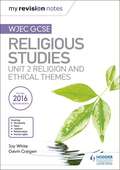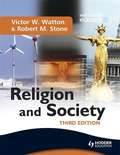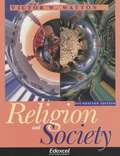- Table View
- List View
Revise AQA GCSE: Revision Workbook (PDF)
by Rob BircherFor the linear specification first teaching 2012. This Revision Workbook delivers question practice, covering one topic per page and closely matching the AQA specification.
Revise AQA GCSE: Foundation (PDF)
by David GrantThis Revision Guide delivers hassle-free exam preparation for Unit 1 and closely matches the AQA specification.
Revise AQA GCSE: Higher (PDF)
by David GrantThis Revision Guide delivers hassle-free exam preparation for Unit 1 and closely matches the AQA specification.
Revise AQA GCSE: Revision Workbook - Foundation
by David GrantThis Revision Workbook delivers hassle-free exam preparation Unit 1 and closely matches the AQA specification.
Revise AQA GCSE: Higher (PDF)
by David GrantThis Revision Workbook delivers hassle-free exam preparation Unit 1 and closely matches the AQA specification.
Revise AQA GCSE: Revision Guide (PDF)
by Harriette LanzerThis Revision Guide delivers hassle-free exam preparation, covering one topic per page and closely matching the AQA specification.
Revise AQA CGSE Additional Science: Revision Workbook Foundation (PDF)
by Mike O'Neil Iain BrandThis Revision Workbook delivers question practice, covering one topic per page and closely matching the AQA specification.
Revise AQA: GCSE French Revision Guide (PDF)
by Julie GreenRevise smart and save! This Revision Guide delivers hassle-free exam preparation, covering one topic per page and closely matching the AQA specification.
Revise AQA: Revision Guide Foundation (PDF)
by Harry SmithRevise smart and save! This Revision Guide delivers hassle-free exam preparation, covering one topic per page and closely matching the AQA specification. Target grades on the page help you to progress at the right speed. Exam Alerts highlight common pitfalls and misconceptions in exam questions. With one-to-one page correspondence between this Guide and the companion Workbook, this hugely popular Revision series offers the best value available for GCSE students.
Resultant and balanced forces (UEB uncontracted)
by Rnib BookshareThis page shows three diagrams separated by two light vertical dashed lines. There is a locator dot shown, which will be at the top left of the page when the image is the right way up. The top diagrams show separate forces acting on three objects. The bottom diagrams show the resultant force (labelled in Newtons) on the same three objects respectively. The diagram on the left shows a block shape at the top of the page with two arrows in a line pointing to the right, and another arrow slightly down. At the bottom of the page, the same block is shown with a line of three arrows pointing to the right. The diagram in the centre shows an ellipse shape at the top of the page with two arrows pointing up and two in a line pointing down. The same ellipse is shown at the bottom of the page with no arrows. The diagram to the right shows a block shape at the top of the page with two arrows in a line pointing to the left and one pointing to the right. The same block is shown at the bottom of the page with one arrow pointing to the left.
Resultant and balanced forces (UEB contracted)
by Rnib BookshareThis page shows three diagrams separated by two light vertical dashed lines. There is a locator dot shown, which will be at the top left of the page when the image is the right way up. The top diagrams show separate forces acting on three objects. The bottom diagrams show the resultant force (labelled in Newtons) on the same three objects respectively. The diagram on the left shows a block shape at the top of the page with two arrows in a line pointing to the right, and another arrow slightly down. At the bottom of the page, the same block is shown with a line of three arrows pointing to the right. The diagram in the centre shows an ellipse shape at the top of the page with two arrows pointing up and two in a line pointing down. The same ellipse is shown at the bottom of the page with no arrows. The diagram to the right shows a block shape at the top of the page with two arrows in a line pointing to the left and one pointing to the right. The same block is shown at the bottom of the page with one arrow pointing to the left.
Resultant and balanced forces (large print)
by Rnib BookshareThis page shows three diagrams separated by two light vertical dashed lines. There is a locator dot shown, which will be at the top left of the page when the image is the right way up. The top diagrams show separate forces acting on three objects. The bottom diagrams show the resultant force (labelled in Newtons) on the same three objects respectively. The diagram on the left shows a block shape at the top of the page with two arrows in a line pointing to the right, and another arrow slightly down. At the bottom of the page, the same block is shown with a line of three arrows pointing to the right. The diagram in the centre shows an ellipse shape at the top of the page with two arrows pointing up and two in a line pointing down. The same ellipse is shown at the bottom of the page with no arrows. The diagram to the right shows a block shape at the top of the page with two arrows in a line pointing to the left and one pointing to the right. The same block is shown at the bottom of the page with one arrow pointing to the left.
The respiration cycle - side view (UEB Uncontracted)
There are two diagrams on the page, one on the top half and one on the bottom half of the page, they both show the lungs and other contents of the chest in diagrammatic form. They are separated by a thin dashed line. A locator dot and title are shown. These must always be at the top left of the page when the image is the right way up. The top diagram shows the principle of breathing in. The rib and sternum have lifted; the diaphragm is pushing down. This increases the capacity of the chest and air goes in. The bottom diagram shows the principle of breathing out. The rib and sternum have moved downwards; the diaphragm has relaxed and moved up. This decreases the capacity of the chest and air goes out.
The respiration cycle - side view (UEB Contracted)
There are two diagrams on the page, one on the top half and one on the bottom half of the page, they both show the lungs and other contents of the chest in diagrammatic form. They are separated by a thin dashed line. A locator dot and title are shown. These must always be at the top left of the page when the image is the right way up. The top diagram shows the principle of breathing in. The rib and sternum have lifted; the diaphragm is pushing down. This increases the capacity of the chest and air goes in. The bottom diagram shows the principle of breathing out. The rib and sternum have moved downwards; the diaphragm has relaxed and moved up. This decreases the capacity of the chest and air goes out.
The respiration cycle - side view (Large Print)
There are two diagrams on the page, one on the top half and one on the bottom half of the page, they both show the lungs and other contents of the chest in diagrammatic form. They are separated by a thin dashed line. A locator dot and title are shown. These must always be at the top left of the page when the image is the right way up. The top diagram shows the principle of breathing in. The rib and sternum have lifted; the diaphragm is pushing down. This increases the capacity of the chest and air goes in. The bottom diagram shows the principle of breathing out. The rib and sternum have moved downwards; the diaphragm has relaxed and moved up. This decreases the capacity of the chest and air goes out.
The respiration cycle - front view (UEB Uncontracted)
There are two diagrams on the page, one on the top half and one on the bottom half of the page, and they both show the lungs and other contents of the chest in diagrammatic form. They are separated by a thin dashed line. A locator dot and title are shown. These must always be at the top left of the page when the image is the right way up. The top diagram shows the principle of breathing in. The ribs and intercostal muscles have lifted; the diaphragm is pushing down. This increases the capacity of the chest and air goes in. The bottom diagram shows the principle of breathing out. The ribs and intercostal muscles have moved downwards; the diaphragm has relaxed and moved up. This decreases the capacity of the chest, and air goes out.
The respiration cycle - front view (UEB Contracted)
There are two diagrams on the page, one on the top half and one on the bottom half of the page, and they both show the lungs and other contents of the chest in diagrammatic form. They are separated by a thin dashed line. A locator dot and title are shown. These must always be at the top left of the page when the image is the right way up. The top diagram shows the principle of breathing in. The ribs and intercostal muscles have lifted; the diaphragm is pushing down. This increases the capacity of the chest and air goes in. The bottom diagram shows the principle of breathing out. The ribs and intercostal muscles have moved downwards; the diaphragm has relaxed and moved up. This decreases the capacity of the chest, and air goes out.
The respiration cycle - front view (Large Print)
There are two diagrams on the page, one on the top half and one on the bottom half of the page, and they both show the lungs and other contents of the chest in diagrammatic form. They are separated by a thin dashed line. A locator dot and title are shown. These must always be at the top left of the page when the image is the right way up. The top diagram shows the principle of breathing in. The ribs and intercostal muscles have lifted; the diaphragm is pushing down. This increases the capacity of the chest and air goes in. The bottom diagram shows the principle of breathing out. The ribs and intercostal muscles have moved downwards; the diaphragm has relaxed and moved up. This decreases the capacity of the chest, and air goes out.
Resistant Materials: Revision Guide (PDF)
by Ian MacdonaldWritten for 2009 curriculum change, Essentials provides concise coverage of all the externally assessed course content and skills for GCSE Resistant Materials. The student-friendly, uncluttered approach guides students through the core content with succinct revision notes and practice questions that focus on the essential content needed for the exams.
Resistance (PDF)
by Owen SheersA thrilling and emotionally intense novel set in a World War Two where Britain has been invaded. Resistance opens in 1944, as the women of a small Welsh farming community wake one morning to find that their husbands have gone. Soon after that a German patrol arrives in their valley.
Religious Studies: Unit 2 - Religion and Ethical Themes (PDF) (My Revision Notes WJEC GCSE)
by Joy White Gavin CraigenTarget success in WJEC GCSE Religious Studies with this proven formula for effective, structured revision; key content coverage is combined with exam-style tasks and practical tips to create a revision guide you can rely on to review, strengthen and test their knowledge. With My Revision Notes you can: - Plan and manage a successful revision programme using the topic-bytopic planner. - Consolidate subject knowledge by working through clear and focused content coverage. - Test understanding and identify areas for improvement with regular 'Now Test Yourself' tasks and answers. - Improve exam technique through practice questions, expert advice and examples of typical mistakes to avoid.
Religions in the Modern World: Traditions and Transformations (2nd edition) (PDF)
by Hiroko Kawanami Christopher Partridge Linda WoodheadComprehensive in its coverage, this completely revised and updated second edition of Religions in the Modern World considers the history and modern practices of the world's main religious traditions. It analyses trends in the manifestation of religion in the modern world, from secularization to the rise of new spiritualities, and is at the cutting edge of developments in the study of religion. Religions in the Modern World is the ideal textbook for those coming to the study of religion for the first time, as well as for those who wish to keep up-to-date with the latest perspectives in the field. Fully international in coverage, it is accessibly written by practising and specialist teachers.
Religion and Society for Edexcel (3rd edition) (PDF)
by Robert M Stone Victor W WattonSupport your students with the most reliable textbook for Edexcel GCSE Religious Studies specification A, Unit 8. Written by experts and endorsed by Edexcel, this book fully supports requirements of a current Edexcel GCSE in Religious Studies specification A, Unit 8. Fully addresses the requirements of the specification in an easy way for your students to understand Makes difficult topics accessible to your students using clear explanations, illustrations and statistics Supports students exam preparation with exam-specific advice, questions and model answers Aids learning with student-focused features, such as key terms and summary boxes. Contents: Section 1 - Religion: Rights and responsibilities Section 2 - Religion: Environmental and medical Issues Section 3 - Religion: Peace and conflict Section 4 - Religion: Crime and punishment
Religion and Society: foundation edition
by Victor W. WattonThe foundation edition of this text is endorsed for use with the EdExcel GCSE course. This title follows the same page layout, style and format as the mainstream edition of Religion and Society and can be used alongside this book in the classroom. The foundation edition covers four specified religions: Christianity, Islam, Judaism and Hinduism and examines religious and social responsibility, religion and the environment, peace and conflict, crime and punishment, and religion and medical issues and science.
Religion and Society: foundation edition
by Victor W. WattonThe foundation edition of this text is endorsed for use with the EdExcel GCSE course. This title follows the same page layout, style and format as the mainstream edition of Religion and Society and can be used alongside this book in the classroom. The foundation edition covers four specified religions: Christianity, Islam, Judaism and Hinduism and examines religious and social responsibility, religion and the environment, peace and conflict, crime and punishment, and religion and medical issues and science.
